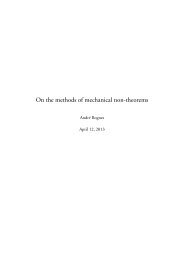The Additivity Theorem in K
The Additivity Theorem in K
The Additivity Theorem in K
You also want an ePaper? Increase the reach of your titles
YUMPU automatically turns print PDFs into web optimized ePapers that Google loves.
THE ADDITIVITY THEOREM IN K-THEORY 189<br />
Now we wish to provide another <strong>The</strong>orem A style proof of additivity<br />
us<strong>in</strong>g the naive homotopy fibers <strong>in</strong>troduced <strong>in</strong> 3.1. We use <strong>The</strong>orem A^ 0 to<br />
convert the <strong>The</strong>orem B style proof <strong>in</strong> [3], which is <strong>in</strong> turn based on<br />
Waldhausen’s proof <strong>in</strong> [7].<br />
For the rest of this section, M will be a small exact category with a chosen<br />
zero object 0. Let KðMÞ denote a space whose homotopy groups are the<br />
K-groups, for example, KðMÞ ¼XjS:Mj. Let E be the category whose objects<br />
are the short exact sequences E: 0 ! M ! N ! P ! 0 of objects <strong>in</strong> M.<br />
Def<strong>in</strong>e s, t, and q: E ! M to be the exact functors send<strong>in</strong>g E to M, N, and P,<br />
respectively.<br />
THEOREM 3.3 (<strong>Additivity</strong> <strong>The</strong>orem). <strong>The</strong> map KðEÞ !<br />
ðs;qÞ<br />
KðMÞ KðMÞ is<br />
a homotopy equivalence.<br />
Proof. It is enough to show that the <strong>in</strong>duced map S:E !<br />
ðs;qÞ<br />
S:M 2 is a<br />
homotopy equivalence. We review some of the details of the proof <strong>in</strong> [3].<br />
For a fixed mP0, consider M 2 SmM. For nP0, an n-simplex of (MjS:q)<br />
is a pair ðP; EÞ where P is an ðm þ n þ 1Þ-simplex of S:M, E is an n-simplex<br />
of S:E, and they are related by P: M V qE. An equivalent condition is<br />
Pi ¼ M and Pj ¼ qE, where i and j are analogous to the maps given <strong>in</strong><br />
diagram (3). Consider the map p: D mþnþ1 ! D m send<strong>in</strong>g all vertices com<strong>in</strong>g<br />
from D n to the top element of D m while act<strong>in</strong>g as the identity on vertices<br />
f0; :::; mg com<strong>in</strong>g from D m . Consider also the exact functor l: M ! E<br />
send<strong>in</strong>g N to 0 ! N ! 1 N ! 0 ! 0. Now def<strong>in</strong>e a map UM : S:M !ðMjS:qÞ<br />
by send<strong>in</strong>g N 2 SnM to ðMp; lNÞ. Note that qlN ¼ 0, so to check that UMðNÞ<br />
is <strong>in</strong> ðMjS:qÞn , we need to check that Mpj ¼ 0, and this follows from the fact<br />
that pj factors through a one element set, together with the remark that the<br />
only 0-simplex of S:M is 0. Next, def<strong>in</strong>e p: ðMjS:qÞ !S:E by send<strong>in</strong>g ðP; EÞ<br />
to E and WM : ðMjS:qÞ !S:M to be S:s p. <strong>The</strong> maps we’ve just def<strong>in</strong>ed fit<br />
<strong>in</strong>to the follow<strong>in</strong>g diagram.<br />
<strong>The</strong> maps WM and UM are simplicial homotopy <strong>in</strong>verses. Indeed, one can see<br />
by <strong>in</strong>spection that WM UM is the identity, so we will construct a simplicial<br />
homotopy from UM WM to 1MjS:q, as a map H: D 1<br />
ðMjS:qÞ !ðMjS:qÞ as<br />
<strong>in</strong> [3]. Observe that ðUM WMÞðP; EÞ ¼UMðsEÞ ¼ðMp; lsEÞ ¼ðPip; lsEÞ.<br />
Suppose ½s; ðP; EÞŠ 2 D 1 n ðMjS:qÞn . We want the first component of

















